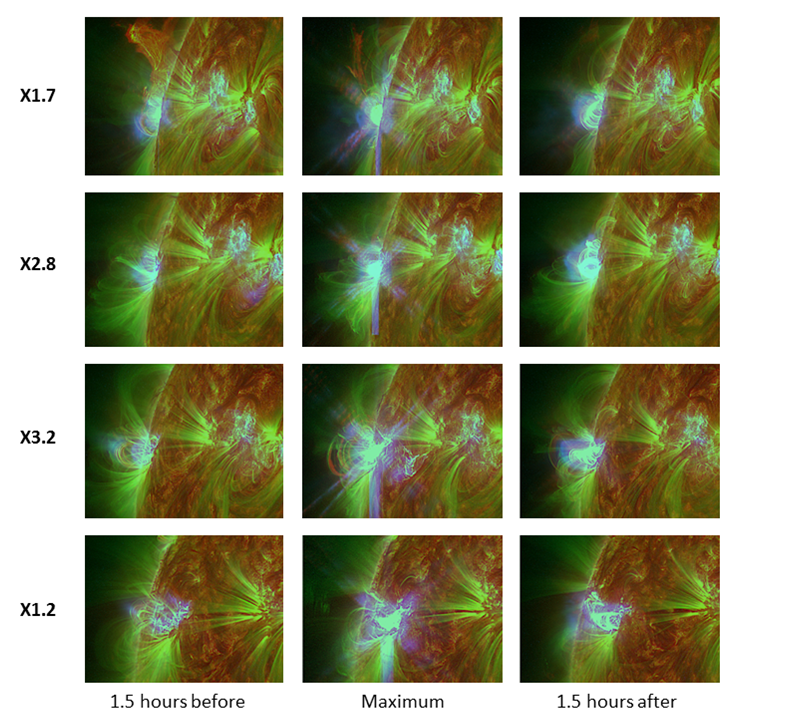Early last week, the Sun produced 4 X-class solar flares in rapid succession. They all originated from NOAA 1748, a magnetically complex region located near the east solar limb. In summary, there was an X1.7 flare on 13 May peaking at 02:17UT, an X2.8 the same day at 16:05UT, an X3.2 early on 14 May at 01:11UT, and the final X1.2 on 15 May at 01:48UT. The SDO images underneath show for each flare the outlook of the region 1.5 hours before the maximum, the maximum itself, and 1.5 hours after the x-ray peak (resp. left, middle and right frame).
The eruptions were extensively covered in a special STCE news item. Related movies can be found here and here.
Supplementary information on CMEs, white light flares, EIT waves, as well as some imagery by STEREO-B, all discussed underneath, can be found in this movie.

All eruptions were accompanied by coronal mass ejections (CMEs), which were quite fast (1000-1600 km/s). However, only for the CME associated with the last X-class flare, NOAA 1748 had already rotated far enough onto the solar disk to get this halo CME also to be geo-effective. Eventually, the particle cloud delivered a glancing blow to the Earth early on 18 May, causing a minor geomagnetic storm. The CME can be seen in this annotated combo image from SOHO and SDO.

The X2.8 and X3.2 flares were actually white light flares (WLFs), as seen by SDO/HMI instrument. The Helioseismic and Magnetic Imager (http://hmi.stanford.edu/) observes the Sun at 617.3nm, which is in the orange part of the visual spectrum. HMI-imagery shows some brightening in both flares for a few minutes around maximum x-ray flux. For the X2.8 flare, it consists of 2 bright points in the trailing portion of the NOAA 1748. For the X3.2 flare, some diffuse patches can be seen near the leading sunspots. WLFs are very rare events, only associated to very energetic events. Satellites such as SDO have a better view than ground-based observatories and have increased the number of WLFs and even extended to less energetic events over the last decade.

The first three X-class events were also associated with EIT-waves. These are shock waves, emanating from the blast site, and travelling through the corona with speeds of a few hundred km/s. In particular the second and third eruption showed obvious EIT-waves, and the disturbances could clearly be seen racing over the east solar limb, as pictured in the difference-images underneath made by the PROBA2/SWAP instrument.

As seen from Earth, NOAA 1748 was rounding the east solar limb and getting better into view for ground- and space-based solar observatories. For STEREO-B, it was the other way around: it had the best views on the first X-class flares, with the last occurring just near the west solar limb. It thus provided a great view on e.g. the first X-class flare and its effects on its surroundings. Image underneath shows the X3.2 flare as seen by STEREO-B.

With its 4 X-flares, NOAA 1748 single-handedly increased the number of X-class flares so far in the current solar cycle (SC) with more than 25%, putting also 2 of these in the current SC24 Top 5 of strongest events. Some details on the eruptions and their geomagnetic influence can be found in table underneath. It is noteworthy that only 4 events resulted from the southern solar hemisphere.

Credits – Imagery for these movies was taken from SOHO, SDO, PROBA2 and STEREO-B.
 |
 |





